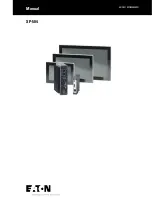
IO-Link basics
EPP6228-0022
16
Version: 1.3
4.3
Device description IODD
IO-Link devices possess individual system information in the form of an IO device description (IODD), which
contains:
• Communication features
• Device parameters with value range and default values
• Identification, process and diagnostic data
• Device data
• Text description
• Picture of the device
• Vendor's logo
If the IODD is imported, then the device data are automatically detected during
with TwinCAT and adopted in the System Manager.
4.4
Parameter server
In order to be able to use the functionality of the parameter server, both the IO-Link master and the IO-Link
device must be specified to V1.1. The IO-Link revision of the device can be read for the individual port under
. All IO-Link masters from Beckhoff with current firmware support the IO-Link specification
V1.1.
• The parameter server in the IO-Link master contains parameter data that are saved in the IO-Link
device. The memory capacity is max. 2 kbyte (including header).
If the IO-Link device is exchanged, then the data are loaded from the parameter server into the new
device. The requirement for this is that the device is of the same type (VendorID and DeviceID must be
the same).
• If a new IO-Link device is configured, then the IO-Link master loads the parameters from the IO-Link
device into the parameter server when starting for the first time.
Data from other IO-Link devices that are already configured (VendorID and DeviceID do not
correspond to the configured device) are overwritten.
• At each further start the IO-Link master uses a checksum to check whether the data in the parameter
server correspond to those on the IO-Link device and if necessary downloads them to the device.
• If the parameters change during the device runtime, this can be reported to the Master via the
(
). The master then starts the parameter server with an
upload.
• By default the event is not set each time the parameters are written, therefore the end of the
parameterization procedure has to be reported to the IO-Link device via the
The IO-Link device then sends the corresponding event to the master. The data are loaded into the
parameter server.
• In the case of a pre-programmed IO-Link device, no download takes place from the parameter server
to the device.
4.5
Data transfer rate
An IO-Link master according to specification V1.1 supports all three transmission methods and automatically
adjusts the baud rate to that of the IO-Link device.
An IO-Link device usually supports only one baud rate. IO-Link devices with different baud rates can be
connected to the various ports of the master.
• COM1 = 4.8 kbaud
• COM2 = 38.4 kbaud
• COM3 = 230.4 kbaud
















































